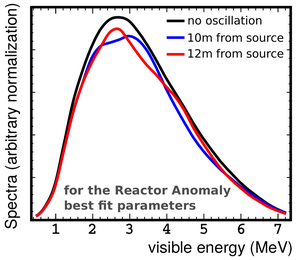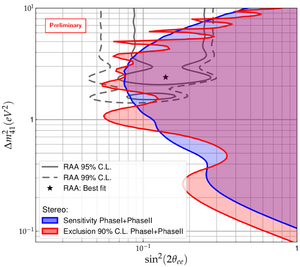Astronomy:STEREO experiment
The STEREO experiment (Search for Sterile Reactor Neutrino Oscillations) investigates the possible oscillation of neutrinos from a nuclear reactor into light so-called sterile neutrinos. It is located at the Institut Laue–Langevin (ILL) in Grenoble, France. The experiment started operating and taking data in November 2016.[1]
Detector
Measuring principle

The STEREO detector is placed at a distance of 10 m away from the research reactor at the ILL. The research reactor has a thermal power of 58 MW. STEREO is supposed to measure the neutrino flux and spectrum near the reactor.[1] To be able to detect the neutrinos radiated from the reactor, the detector is filled up with 1800 litres of organic liquid scintillator which is doped with gadolinium.[2] Inside the scintillator neutrinos are captured via the process of inverse beta decay
In this process a positron is produced. When the positron moves through the scintillator a light signal is produced, which is detected by the 48 photomultiplier tubes (PMTs) placed at the top of the detector cells.[3] The capturing of the neutron which is also produced during the inverse beta decay produces a second coincidence signal.
The expected distance between the oscillation maximum and minimum of light sterile neutrinos is about 2 m. To see the oscillation the detector is divided into 6 separate detector cells, which each measure the energy spectrum of the detected neutrinos. By comparing the measured spectra a possible oscillation could be discovered (see Figure 2).
The STEREO experiment detects neutrinos per day.[4]
Detector shielding
Neutrinos only interact weakly. Therefore, neutrino detectors such as STEREO need to be very sensitive and need a good shielding from additional background signals to be able to detect neutrinos precisely.[1]
To achieve this high sensitivity the 6 inner detector cells are surrounded by a liquid scintillator (without gadolinium) which acts as a "Gamma-Catcher" detecting in- and outgoing gamma radiation. This significantly increases the detection efficiency as well as the energy resolution of the detector. A cherenkov detector filled with water is placed on top of the detector to detect cosmic muons which are produced in the atmosphere and would otherwise act as a large background source. To shield the detector from radioactive sources coming from surrounding experiments it is surrounded and shielded by many layers (65 t) of mostly lead and polyethylene but also iron, steel and .
Motivation

Although neutrino oscillation is a phenomenon that is quite well understood today, there are still some experimental observations that question the completeness of our understanding. The most prominent of these observations is the so-called reactor antineutrino anomaly (RAA) (see Figure 3). A number of short baseline reactor-neutrino experiments have measured a significantly lower anti-electron neutrino (νe) flux compared to the theoretical predictions (a 2,7 σ deviation).[5] Further experimental anomalies are the unexpected appearance of νe in a short-baseline νμ beam (LSND anomaly)[6] as well as the disappearance of νe at short distances during the calibration phase of the GALLEX[7] and SAGE[8] experiments known as the gallium neutrino anomaly.

These anomalies could signify that our understanding of neutrino oscillations is not yet complete and that neutrinos oscillate into another 4th neutrino species. However measurements of the decay width of the Z boson at the Large Electron–Positron Collider (LEP) exclude the existence of a light 4th "active" (i.e. interacting via the weak force) neutrino.[9] Hence the oscillation into additional light "sterile" neutrinos is considered as a possible explanation of the observed anomalies. In addition sterile neutrinos appear in many prominent extensions of the Standard Model of particle physics, e.g. in the seesaw type 1 mechanism.
Results as of December 2019
Initial results were released in 2018 exploiting a dataset of 66 days of reactor turned on.[10] Most of the parameter space that could account for the RAA was excluded at a 90% confidence level. Updated results in December 2019 are based on ≈ 65,500 detected neutrinos (combined phase 1 and 2, 179 days of reactor-on data). Using the current data the region of exclusion is further extended (see figure 4).[11]
External links
References
- ↑ 1.0 1.1 1.2 Allemandou, N. et al. (2018). "The STEREO experiment". Journal of Instrumentation 13 (7): P07009. doi:10.1088/1748-0221/13/07/P07009. Bibcode: 2018JInst..13P7009A.
- ↑ Buck, C.; Gramlich, B.; Lindner, M.; Roca, C.; Schoppmann, S. (2019). "Production and properties of the liquid scintillators used in the STEREO reactor neutrino experiment". Journal of Instrumentation 14 (1): P01027. doi:10.1088/1748-0221/14/01/P01027. Bibcode: 2019JInst..14P1027B.
- ↑ Bourrion, O. et al. (2016). "Trigger and readout electronics for the STEREO experiment". Journal of Instrumentation 11 (2): C02078. doi:10.1088/1748-0221/11/02/c02078.
- ↑ Bernard, Laura (2019). "Results from the STEREO Experiment with 119 days of Reactor-on Data". arXiv:1905.11896 [hep-ex].
- ↑ Mention, G.; Fechner, M.; Lasserre, Th.; Mueller, Th.A.; Lhuillier, D.; Cribier, M.; Letourneau, A. (2011). "Reactor antineutrino anomaly". Physical Review D 83 (7): 073006. doi:10.1103/PhysRevD.83.073006. Bibcode: 2011PhRvD..83g3006M.
- ↑ Aguilar, A.; Auerbach, L.B.; Burman, R.L.; Caldwell, D.O.; Church, E.D.; Cochran, A.K. et al. (2001). "Evidence for neutrino oscillations from the observation of νe appearance in a νμ beam". Physical Review D 64 (11): 112007. doi:10.1103/PhysRevD.64.112007.
- ↑ Giunti, Carlo; Laveder, Marco (2011). "Statistical significance of the gallium anomaly". Physical Review C 83 (6): 065504. doi:10.1103/PhysRevC.83.065504. Bibcode: 2011PhRvC..83f5504G.
- ↑ Abdurashitov, J.N.; Gavrin, V.N.; Girin, S.V.; Gorbachev, V.V.; Gurkina, P.P.; Ibragimova, T.V. et al. (2006). "Measurement of the response of a Ga solar neutrino experiment to neutrinos from a 37Ar source". Physical Review C 73 (4): 045805. doi:10.1103/PhysRevC.73.045805. Bibcode: 2006PhRvC..73d5805A.
- ↑ Allemandou, N.; Almazán, H.; del Amo Sanchez, P.; Bernard, L.; Bernard, C.; Blanchet, A. et al. (2006). "Precision electroweak measurements on the Z resonance". Physics Reports 427 (5–6): 257–454. doi:10.1016/j.physrep.2005.12.006. Bibcode: 2006PhR...427..257A.
- ↑ Almazán, Helena; Bernard, Laura (2018). "Sterile neutrino constraints from the STEREO experiment with 66 days of reactor-on data". Physical Review Letters 121 (16): 161801. doi:10.1103/PhysRevLett.121.161801. PMID 30387650. Bibcode: 2018PhRvL.121p1801A.
- ↑ Almazán, Helena; Bernard, Laura (2020). "Improved sterile neutrino constraints from the STEREO experiment with 179 days of reactor-on data". Physical Review D 102 (5): 052002. doi:10.1103/PhysRevD.102.052002. Bibcode: 2020PhRvD.102e2002A.
 |

